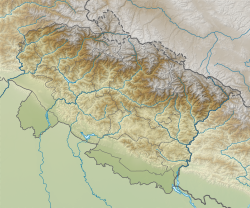
Back जागेश्वर धाम, अल्मोड़ा Hindi ಜಾಗೇಶ್ವರ್ Kannada Jageshwar Polish Джагешвар Russian Джаґешвар Ukrainian جاگشور Urdu
Jageshwar
जागेश्वर | |
|---|---|
| Coordinates: 29°38′N 79°51′E / 29.633°N 79.850°E | |
| Elevation | 1,870 m (6,140 ft) |
| Population (20
11) | |
• Total | 14,000 |
| Languages | |
| • Official | Hindi |
| Time zone | UTC+5:30 (IST) |
| Telephone code | 05962 |
| Vehicle registration | UK-01 |
| Website | uk |
Jageshwar is a Hindu pilgrimage town near Almora in Almora district of the Himalayan Indian state of Uttarakhand. It is one of the Dhams (pilgrimage region) in the Shaivism tradition. The site is protected under Indian laws, and managed by the Archaeological Survey of India (ASI). It includes Dandeshwar Temple, Chandi-ka-Temple, Jageshwar Temple, Kuber Temple, Mritunjaya Temple, Nanda Devi or Nau Durga, Nava-grah temple, a Pyramidal shrine, and Surya Temple. The site celebrates the Jageshwar Monsoon Festival during the Hindu calendar month of Shravan (overlaps with July–August) and the annual Maha Shivratri Mela (Shivratri festival), which takes place in early spring.
Jageshwar Temples, also referred to as Jageswar Temples or Jageshwar Valley Temples, are a group of 125 ancient Hindu temples dated between 7th and 14th century, [1] The valley has a number of temple clusters such as the Dandeshwar and Jageshwar sites. Some locations have attracted construction of new temples through the 20th-century. Together these clusters over the valley consist of over 200 structural temples built from cut stone. Many are small, while a few are substantial. They predominantly illustrate North Indian Nagara style of architecture with a few exceptions that show South and Central Indian style designs, many are dedicated to god Shiva, while others in immediate vicinity are dedicated to god Vishnu, Shakti goddesses and Surya traditions of Hinduism.[1][2]
There are other Hindu temples in the Himalayan region that are called Jageshwar Temple such as one in Dalash, Himachal Pradesh.[3]
- ^ a b Nachiket Chanchani 2013, pp. 133–154.
- ^ Aśoka Jeratha (1995). The Splendour of Himalayan Art and Culture. Indus. pp. 71–73. ISBN 978-81-7387-034-7.
- ^ Omacanda Hāṇḍā (2001). Temple Architecture of the Western Himalaya: Wooden Temples. Indus. pp. 252–256. ISBN 978-81-7387-115-3.

